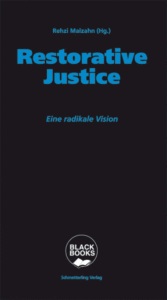Für viele Laien scheint es unvorstellbar, dass man auch im Kontext geschlechtsbezogener und sexualisierter Gewalt Restorative Justice Verfahren anwenden kann.
Abgesehen davon, dass die Entscheidung grundsätzlich bei den Betroffenen liegt und nicht bei Leuten, die sich etwas nicht vorstellen können, hier ein paar Quellen und Hinweise.
- WEBINAR (englisch) des European Forum for Restorative Justice am 8 März: »Making Restorative Justice possible« Anmeldungen sind offen. Mit
- Valentina Bonini (Italy) – Exclusion criteria in the law to access restorative justice in cases of violence against women.
- Linda Millington & Janet Clark (UK) – A facilitator’s practical experience on restorative justice with cases of sexual and domestic abuse.
- Pascale Frank (Belgium) – An holistic restorative approach to respond to domestic violence in Family Justice Centers.
- Marie Keenan (Ireland) – The tragedy and sorrow of familicide: can restorative justice help?
- Alexia Stourati (Greece) – Healing circles as a safe space of sharing and empowerment for survivors of sexual violence.
2. Filme
- The Meeting. (Englisch) »She didn’t want an apology. She wanted her life back.« Online ansehbar für 4,99€
The film is based on a real meeting which took place between Ailbhe Griffith and the man who, nine years earlier, subjected her to a horrific sexual assault and left her seriously injured and fearing for her life. Ailbhe plays herself in the film. - Hollow Water (Englisch) Kostenlos online ansehbar.
This documentary profiles the tiny Ojibway community of Hollow Water on the shores of Lake Winnipeg as they deal with an epidemic of sexual abuse in their midst. The offenders have left a legacy of denial and pain, addiction and suicide. The Canadian justice system was unsuccessful in ending the cycle of abuse, so the community of Hollow Water took matters into their own hands. Based on traditional practices, this unique model of justice reunites families and heals both victims and offenders.
3. Bücher
- Thordis Elva, Tom Stranger: Ich will dir in die Augen sehen.
»Eine Frau trifft den Mann, der sie vergewaltigt hat.«
Das Buch beschreibt nicht eigentlich einen RJ-Prozess, und doch kommt darin sehr viel davon vor, was ein RJ Prozess sein kann. Thordis und Tom sind heute große Unterstützer von RJ, und Thordis hätte sich die Unterstützung, die RJ bieten kann, für ihren Prozess gewünscht, wie sie in einem Interview erklärte. - Handbuch für RJ im Kontext sexualisierter Gewalt (englisch) entstanden aus dem EU-Forschungsprojekt »Developing integrated responses to sexual violence – an interdisciplinary research project on the potential of Restorative Justice« der KU Leuven.
- Judah Oudshoorn, Lorraine Stutzman Amstutz, Michelle Jackett: The Little Book of Restorative Justice for Sexual Abuse: Hope through Trauma. (englisch)
Criminal justice approaches tend to sideline and re-traumatize victims, and punish offenders to the detriment of accountability. Alternatively, restorative justice centers on healing for victims, while holding offenders meaningfully accountable. Criminal justice responses tend to individualize the problem, and catch marginalized communities, such as ethnic minorities, within its net. Restorative justice recognizes that sexual abuse is a form of gender-based violence.
4. Working Group des European Forum (englisch) »EFRJ recognizes and respects the concerns that many people have over restorative responses to gender-based violence. There are real risks of victimization due to imbalances of power and control. Such violence is often deeply traumatic for the victim. This working group will be responsible for addressing these challenges and developing models of restorative justice, which are safe, anti- oppressive and effective.«


